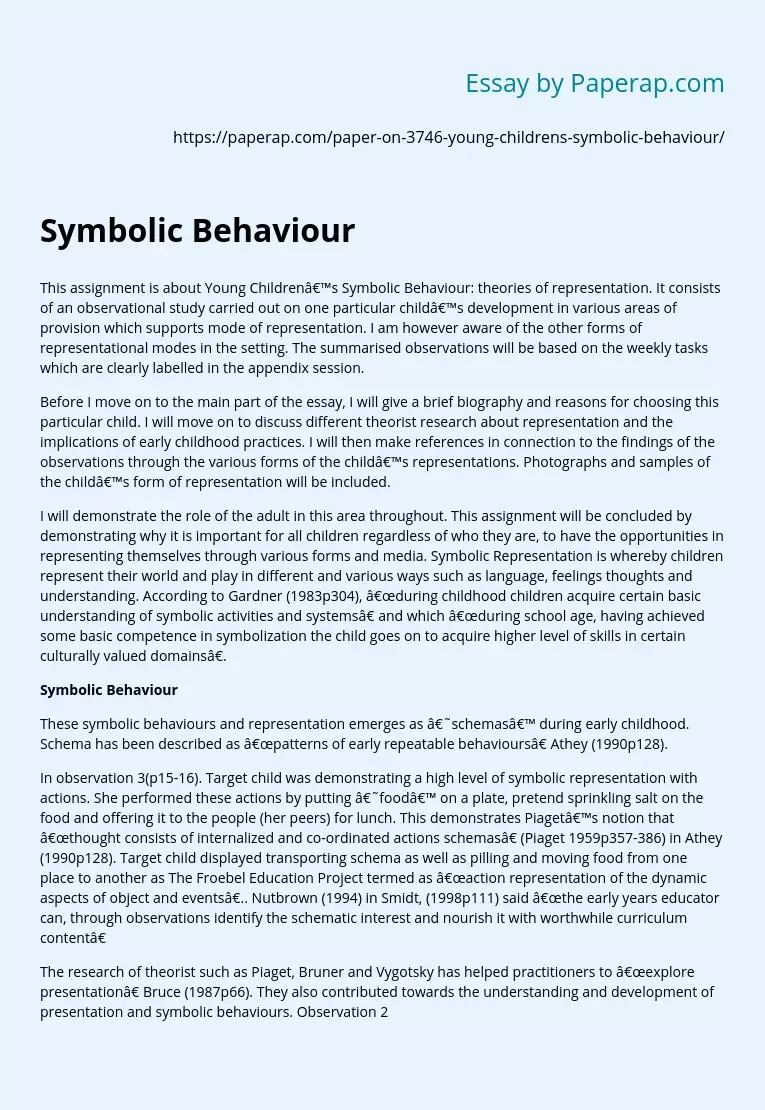Symbolic Behaviour
This assignment is about Young Children’s Symbolic Behaviour: theories of representation. It consists of an observational study carried out on one particular child’s development in various areas of provision which supports mode of representation. I am however aware of the other forms of representational modes in the setting. The summarised observations will be based on the weekly tasks which are clearly labelled in the appendix session.
Before I move on to the main part of the essay, I will give a brief biography and reasons for choosing this particular child.
I will move on to discuss different theorist research about representation and the implications of early childhood practices. I will then make references in connection to the findings of the observations through the various forms of the child’s representations. Photographs and samples of the child’s form of representation will be included.
I will demonstrate the role of the adult in this area throughout. This assignment will be concluded by demonstrating why it is important for all children regardless of who they are, to have the opportunities in representing themselves through various forms and media.
Symbolic Representation is whereby children represent their world and play in different and various ways such as language, feelings thoughts and understanding. According to Gardner (1983p304), “during childhood children acquire certain basic understanding of symbolic activities and systems” and which “during school age, having achieved some basic competence in symbolization the child goes on to acquire higher level of skills in certain culturally valued domains”.
Symbolic Behaviour
These symbolic behaviours and representation emerges as ‘schemas’ during early childhood. Schema has been described as “patterns of early repeatable behaviours” Athey (1990p128).
In observation 3(p15-16). Target child was demonstrating a high level of symbolic representation with actions. She performed these actions by putting ‘food’ on a plate, pretend sprinkling salt on the food and offering it to the people (her peers) for lunch. This demonstrates Piaget’s notion that “thought consists of internalized and co-ordinated actions schemas” (Piaget 1959p357-386) in Athey (1990p128). Target child displayed transporting schema as well as pilling and moving food from one place to another as The Froebel Education Project termed as “action representation of the dynamic aspects of object and events”.. Nutbrown (1994) in Smidt, (1998p111) said “the early years educator can, through observations identify the schematic interest and nourish it with worthwhile curriculum content”
The research of theorist such as Piaget, Bruner and Vygotsky has helped practitioners to “explore presentation” Bruce (1987p66). They also contributed towards the understanding and development of presentation and symbolic behaviours. Observation 2(p12-14) shows how target child represents her play symbolically by using her imagination of sitting on a donkey and riding it. This Piaget in Ginsbury & Opper (1988p70) termed as “appearance of the semionitic function” which means children uses objects in representing “something else which is not present”.
This observation also identifies Bruner’s enactive, iconic and symbolic mode of representation. Target child did “replace the action with an image” and used appropriate language in describing her play. Bruce (1987p66) Vygotsky on the other hand talked about the theory of ‘actual development’ which links in to where target child initiated her own imaginary play without the help of an adult or peer Bruce (1987).
Children represent themselves in various ways. Target child’s preferred representation is mark making, which Matthews (2003p74) termed it as “Visual representation and expression”. Samples of these mark making can be found on (p24). Her representation in this observation (observation 4p19) reflects Matthews (2003pg27) idea about how “first and second generation mark-making gestures are organised together and undergo transformation”.
Symbolic Behaviour. (2019, Dec 05). Retrieved from https://paperap.com/paper-on-3746-young-childrens-symbolic-behaviour/

